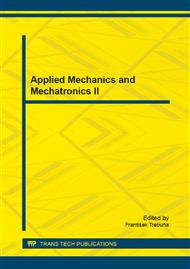[1]
J. Jiang, Y. Zhang, A novel variable-length sliding window blockwise least-squares algorithm for on-line estimation of time-varying parameters, in: International journal of adaptive control and signal processing, Vol. 18, no. 7, 2004, pp.571-587.
DOI: 10.1002/acs.811
Google Scholar
[2]
K.S. Naredra, J. Balakrishnan, Improving transient response of adaptive control systems using multiple models and switching, in: IEEE Transactions on Automatic Control, Vol. 39, no 10, 1994, pp.1861-1866.
DOI: 10.1109/9.317113
Google Scholar
[3]
K.S. Naredra, J. Balakrishnan, Adaptive control using multiple models, in: IEEE Transactions on Automatic Control, Vol. 42, no 2, 1997, pp.171-187.
DOI: 10.1109/9.554398
Google Scholar
[4]
A. Ibeas, M. Sen, S. Alonso-Quesada, A supervised multiestimation scheme for discrete adaptive control, in: Proceedings of the 7th International Conference on Control, Automation, Robotics and Vision, Singapore, 2002, pp.659-664.
DOI: 10.1109/icarcv.2002.1238500
Google Scholar
[5]
J. Mikleš, M. Fikar, Process modelling, identification, and control, Springer, 2007. ISBN 35-407-1969-5.
Google Scholar
[6]
V. Bobál, J. Böhm, J. Fessl, J. Macháček, Digital Self-tuning Controllers: Algorithms, Implementation and Applications, Springer, London, 2005. ISBN 18-523-3980-2.
Google Scholar
[7]
L. Ljung, System identification – theory for user, New Jersey: Prentice-Hall, 1987. ISBN 0-13-881640-9.
Google Scholar
[8]
T. Söderström, P. Stoica, System Identification, Cambridge: Prentice Hall, University Press, 1989. ISBN 0-13-881236-5.
Google Scholar
[9]
P.E. Wellstead, M.B. Zarrop, Self-Tuning System – Control and Signal Processing, John Wiley & Sons, New York, 1991. ISBN 0-471-93054-7.
Google Scholar
[10]
R. Kulhavý, Restricted exponential forgetting in real time identification, in: Automatica, Vol. 23, 1987, pp.586-600.
DOI: 10.1016/0005-1098(87)90054-9
Google Scholar
[11]
R. Kulhavý, M.B. Zarrop, On a general concept of forgetting, in: International Journal of Control, Vol 58, no 4, 1993, p.905–924.
DOI: 10.1080/00207179308923034
Google Scholar
[12]
J.P. Corriou, Process Control : Theory and Applications, London: Springer-Verlag, 2004. ISBN 1-85233-776-1.
Google Scholar
[13]
O. Nelles, Nonlinear system identification, Berlin: Springer-Verlag, 2001. ISBN 3-540-67369-5.
Google Scholar
[14]
I. Branica, N.; Peric, I. Petrovic, Comparison of Several Recursive Identification Methods, in: Automatika, Vol. 37, no. 3-4, 1996, pp.99-104.
Google Scholar


